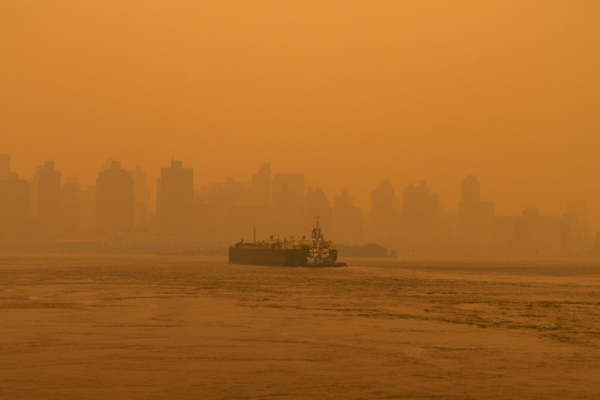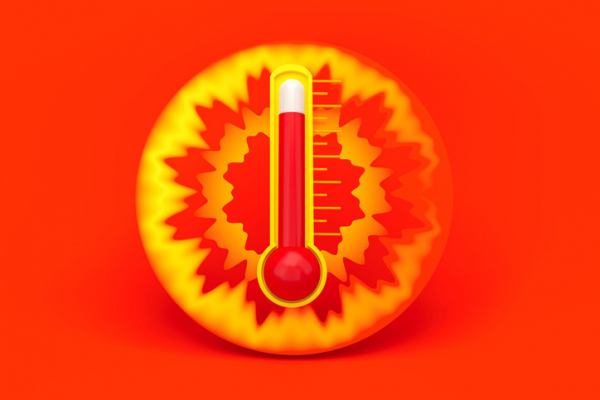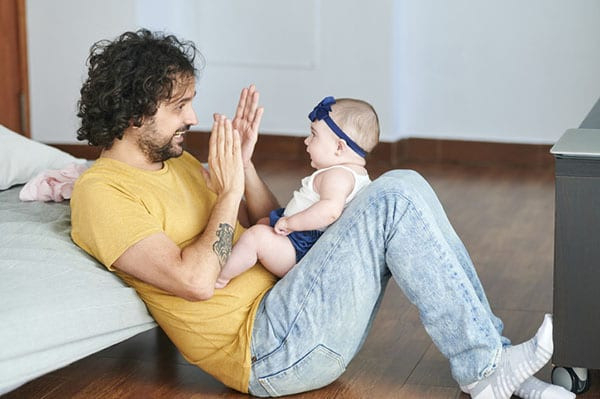
Wildfires: How to cope when smoke affects air quality and health

As wildfires become more frequent due to climate change and drier conditions, more of us and more of our communities are at risk for harm. Here is information to help you prepare and protect yourself and your family.
How does wildfire smoke affect air quality?
Wildfire smoke contributes greatly to poor air quality. Just like fossil fuel pollution from burning coal, oil, and gas, wildfires create hazardous gases and tiny particles of varying sizes (known as particulate matter, or PM10, PM2.5, PM0.1) that are harmful to breathe. Wildfire smoke also contains other toxins that come from burning buildings and chemical storage.
The smoke can travel to distant regions, carried by weather patterns and jet streams.
How does wildfire smoke affect our health?
The small particles in wildfire smoke are the most worrisome to our health. When we breathe them in, these particles can travel deep into the lungs and sometimes into the bloodstream.
The health effects of wildfire smoke include eye irritation, coughing, wheezing, and difficulty breathing. The smoke may also increase risk for respiratory infections like COVID-19. Other possible serious health effects include heart failure, heart attacks, and strokes.
Who needs to be especially careful?
Those most at risk from wildfire smoke include children, older adults, outdoor workers, and anyone who is pregnant or who has heart or lung conditions.
If you have a chronic health condition, talk to your doctor about how the smoke might affect you. Find out what symptoms should prompt medical attention or adjustment of your medications. This is especially important if you have lung problems or heart problems.
What can you do to prepare for wildfire emergencies?
If you live in an area threatened by wildfires, or where heat and dry conditions make them more likely to occur:
- Create an evacuation plan for your family before a wildfire occurs.
- Make sure that you have several days on hand of medications, water, and food that doesn't need to be cooked. This will help if you need to leave suddenly due to a wildfire or another natural disaster.
- Regularly check this fire and smoke map, which shows current wildfire conditions and has links to state advisories.
- Follow alerts from local officials if you are in the region of an active fire.
What steps can you take to lower health risks during poor air quality days?
These six tips can help you stay healthy during wildfire smoke advisories and at other times when air quality is poor:
- Stay aware of air quality. AirNow.gov shares real-time air quality risk category for your area accompanied by activity guidance. When recommended, stay indoors, close doors, windows, and any outdoor air intake vents.
- Consider buying an air purifier. This is also important even when there are no regional wildfires if you live in a building that is in poor condition. See my prior post for tips about pollution and air purifiers. The EPA recommends avoiding air cleaners that generate ozone, which is also a pollutant.
- Understand your HVAC system if you have one. The quality and cleanliness of your filters counts, so choose high-efficiency filters if possible, and replace these as needed. It's also important to know if your system has outdoor air intake vents.
- Avoid creating indoor pollution. That means no smoking, no vacuuming, and no burning of products like candles or incense. Avoid frying foods or using gas stoves, especially if your stove is not well ventilated.
- Make a "clean room." Choose a room with fewer doors and windows. Run an air purifier that is the appropriate size for this room, especially if you are not using central AC to keep cool.
- Minimize outdoor time and wear a mask outside. Again, ensuring that you have several days of medications and food that doesn't need to be cooked will help. If you must go outdoors, minimize time and level of activity. A well-fitted N95 or KN95 mask or P100 respirator can help keep you from breathing in small particles floating in smoky air (note: automatic PDF download).
About the Author

Wynne Armand, MD, Contributor
Dr. Wynne Armand is a physician at Massachusetts General Hospital (MGH), where she provides primary care; an assistant professor in medicine at Harvard Medical School; and associate director of the MGH Center for the Environment and … See Full Bio View all posts by Wynne Armand, MD

A hot weather plan is essential to staying healthy

Here’s a new fact about spring, summer, fall, and sometimes even winter: now that climate change has blurred seasonal boundaries, sizzling heat may be on the way, or currently blanketing your community.
High temperatures stress the body, leading to thousands of heat-related illnesses and deaths every year in the US. Creating a personal heat plan can help you stay safe when the heat index soars.
Caleb Dresser, MD, MPH, is the health care solutions lead for C-CHANGE, the Center for Climate Health and the Global Environment at the Harvard T.H. Chan School of Public Health, and an emergency medicine doctor at Harvard-affiliated Beth Israel Deaconess Medical Center. Below we interview him about who, how, and why heat harms. Then we’ll help you create your personal heat safety plan.
Interview edited for clarity
Who is especially vulnerable during hot weather?
High temperatures can affect anyone. But some people — children, outdoor workers, people who are pregnant or have health problems or disabilities, and older people — are more likely to experience harm when temperatures rise. For example:
- Young children, especially babies, have less physical capacity to deal with very high temperatures.
- People working outdoors may not have access to shade and could be performing physically intensive labor. They need adequate hydration, adequate breaks, and access to a cool space during break time, as OSHA guidelines spell out.
- People with chronic medical conditions, such as kidney disease or heart disease, may have difficulty adapting physiologically to hot weather, or may be more susceptible to its health impacts.
- And some people living with disabilities or certain neurological conditions may have difficulty with thermoregulation — that is, controlling the temperature of their bodies — or may not be able to take actions that keep them safe, such as taking off layers or moving to a cool area.
Which weather patterns create dangerous levels of heat?
Dangerous heat is the result of both high temperatures and high humidity, which interfere with our ability to cool off by sweating. In dry areas, extremely hot temperatures can be dangerous on their own.
Danger zones vary across the United States and around the world. But hospital use and deaths rise once we get above threshold temperatures. The threshold varies in different places depending on whether bodies, cultures, and architecture are adapted to heat.
For example, here in New England, where some people (particularly those of limited means) may not have access to air conditioning, we see increases in healthcare use and deaths at a lower temperature than in the American South, where people and organizations may be more used to dealing with hot weather.
When does hot weather become dangerous to our health?
Risk goes up the longer hot weather sticks around.
One hot day can put some people at risk. A stretch of several hot days in a row during a heat wave is particularly dangerous because it can overwhelm people’s ability to adapt. Eventually people run out of physiological reserves, leading to greater health harms and greater need for medical care.
Surprisingly, spring and early summer are particularly dangerous times because people and organizations aren’t as prepared for hot weather.
How to create your personal heat safety plan
Five key points to help you create a personal heat plan are below. Americares offers further information through heat tip sheets developed with the Harvard C-CHANGE team that are tailored to people in different health circumstances.
Planning is important because intense heat is occurring more often: a Climate Central analysis found 21 additional risky heat days, on average, for 232 out of 249 locations between 1970 and 2022.
- Stay ahead of hot weather. Check apps, websites, TV, or radio for updates on weather today and in coming days. If local weather alerts are available by phone or text, sign up.
- Have a cooling plan. When temperatures soar, you need to spend as much time as possible in cool spaces. Plan options if your home is likely to be too hot and unsafe to stay in. You may be able to stay with a neighbor or family member who has air conditioning until a heat wave passes. Many cities and towns have neighborhood splash pads for children, and open cooling centers or air-conditioned libraries, public buildings, or community centers to everyone — sometimes even overnight. Spending time in air-conditioned businesses or malls, or in a shady green space like a park, may help too.
- Sip plenty of fluids. Water is the best choice. Skip sugary drinks and avoid caffeine or alcohol.
- Use fans correctly. Fans help if surrounding air is relatively cool. If air temperatures are very high, it’s important to dampen your clothes or skin to help keep your body from overheating, and move to a cooler location, if possible.
- Know your personal risks and the signs of heat-related illness. If you have health problems or disabilities, or take certain medicines such as diuretics, talk to your doctor about the best ways for you to cope with heat. It’s also essential to know the signs of heat-related illnesses, which range from heat rash and sunburn to heat cramps, heat exhaustion, and heat stroke. This chart from the Centers for Disease Control and Prevention describes the signs to look for and what you can do, particularly when heat becomes an emergency.
About the Author

Francesca Coltrera, Editor, Harvard Health Blog
Francesca Coltrera is editor of the Harvard Health Blog, and a senior content writer and editor for Harvard Health Publishing. She is an award-winning medical writer and co-author of Living Through Breast Cancer and The Breast … See Full Bio View all posts by Francesca Coltrera
About the Reviewer

Howard E. LeWine, MD, Chief Medical Editor, Harvard Health Publishing
Dr. Howard LeWine is a practicing internist at Brigham and Women’s Hospital in Boston, Chief Medical Editor at Harvard Health Publishing, and editor in chief of Harvard Men’s Health Watch. See Full Bio View all posts by Howard E. LeWine, MD

Why play? Early games build bonds and brain

Want your child to grow up healthy, happy, smart, capable, and resilient? Play with them. Infants and toddlers thrive on playful games that change as they grow.
Why does play matter during the first few years of life?
More than a million new nerve connections are made in the brain in the first few years of life. And pruning of these neural connections makes them more efficient. These processes literally build the brain and help guide how it functions for the rest of that child’s life. While biology — particularly genetics — affects this, so does a child’s environment and experiences.
Babies and children thrive with responsive caregiving. Serve and return, a term used by the Harvard Center on the Developing Child, describes this well: back-and-forth interactions, in which the child and caregiver react to and interact with each other in a loving, nurturing way, are the building blocks of a healthy brain and a happy child, who will have a better chance of growing into a healthy, happy, competent, and successful adult.
Play is one of the best ways to do responsive caregiving. To maximize the benefits of play:
- Bring your full attention. Put the phone down, don’t multitask.
- Be reciprocal. That’s the “serve and return” part. Even little babies can interact with their caregivers, and that’s what you want to encourage. It doesn’t have to be reciprocal in an equal way — you might be talking in sentences while your baby is just smiling or cooing — but the idea is to build responsiveness into the play.
- Be attuned to developmental stages. That way your child can fully engage — and you can encourage their development as well.
Great games to play with infants: 6 to 9 months
The Center for the Developing Child has some great ideas and handouts for parents about specific games to play with their children at different ages.
6-month-olds and 9-month-olds are learning imitation and other building blocks of language. They are also starting to learn movement and explore the world around them.
Here are some play ideas for this age group:
- Play peek-a-boo or patty-cake.
- Play games of hiding toys under a blanket or another toy, and then “find” them, or let the baby find them.
- Have back-and-forth conversations. The baby’s contribution might just be a “ma” or “ba” sound. You can make the same sound back, or pretend that your baby is saying something (“You don’t say! Really? Tell me more!”).
- Play imitation games: if your baby sticks out their tongue, you do it too, for example. Older babies will start to be able to imitate things like clapping or banging, and love when grownups do that with them.
- Sing songs that involve movement, like “Itsy Bitsy Spider” or “Trot, Trot to Boston” with words and motions.
- Play simple games with objects, like putting toys into a bucket and taking them out, or dropping them and saying “boom!”
Great games to play with toddlers
Between 12 months and 18 months, young toddlers are gaining more language and movement skills, and love to imitate. You can:
- Play with blocks, building simple things and knocking them down together.
- Do imaginative play with dolls or stuffed animals, or pretend phone calls.
- Use pillows and blankets to build little forts and places to climb and play.
- Play some rudimentary hide-and-seek, like hiding yourself under a blanket next to the baby.
- Continue singing songs that involve movement and interaction, like “If You’re Happy And You Know It.”
- Go on outings and explore the world together. Even just going to the grocery store can be an adventure for a baby. Narrate everything. Don’t worry about using words your baby doesn’t understand; eventually they will, and hearing lots of different words is good for them.
Older toddlers, who are 2 or 3 years old, are able to do more complicated versions of these games. They can do matching, sorting, and counting games, as well as imitation and movement games like “follow the leader” (you can get quite creative and silly with that one).
As much as you can, give yourself over to play and have fun. Work and chores can wait, or you can actually involve young children in chores, making that more fun for both of you. Checking social media can definitely wait.
Playing with your child is an investment in your child’s future — and a great way to build your relationship and make both of you happy.
About the Author

Claire McCarthy, MD, Senior Faculty Editor, Harvard Health Publishing
Claire McCarthy, MD, is a primary care pediatrician at Boston Children’s Hospital, and an assistant professor of pediatrics at Harvard Medical School. In addition to being a senior faculty editor for Harvard Health Publishing, Dr. McCarthy … See Full Bio View all posts by Claire McCarthy, MD